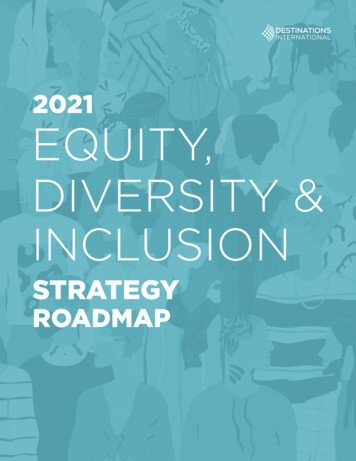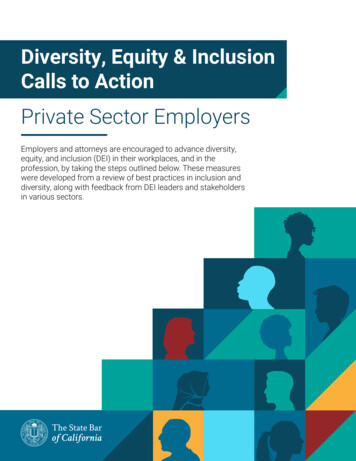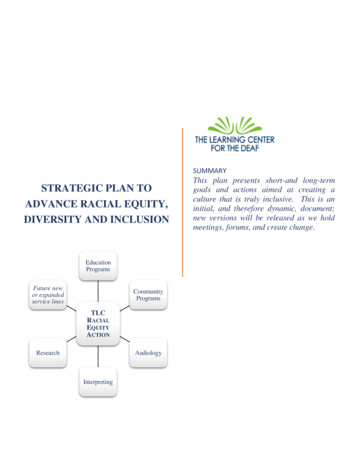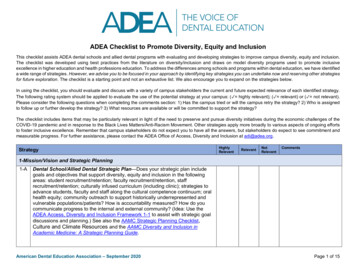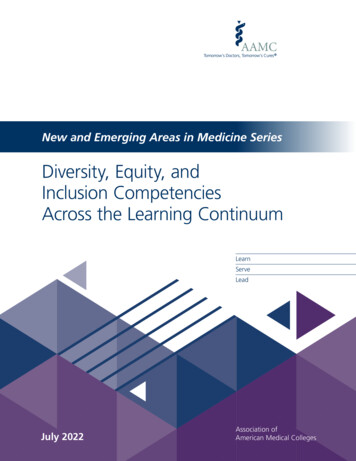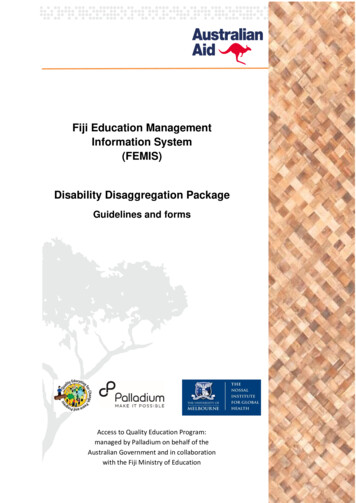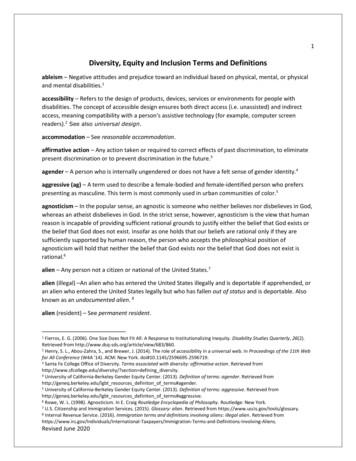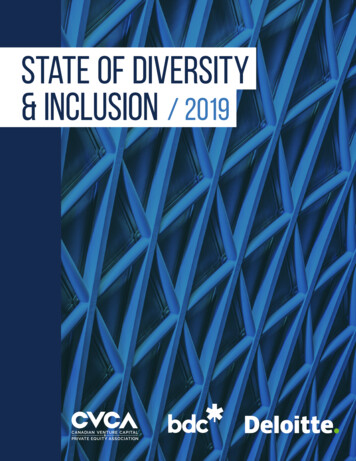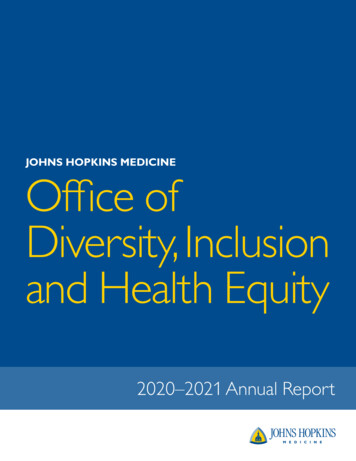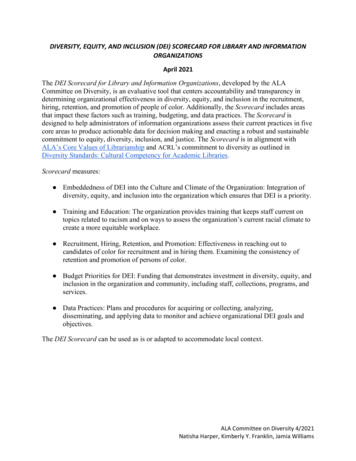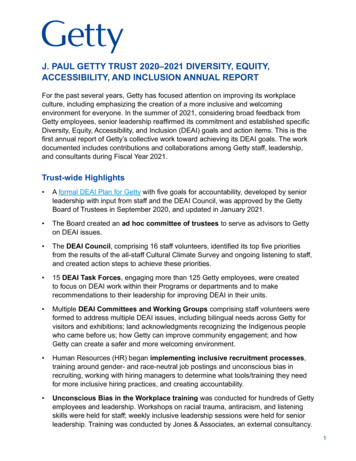
Transcription
J. PAUL GETTY TRUST 2020–2021 DIVERSITY, EQUITY,ACCESSIBILITY, AND INCLUSION ANNUAL REPORTFor the past several years, Getty has focused attention on improving its workplaceculture, including emphasizing the creation of a more inclusive and welcomingenvironment for everyone. In the summer of 2021, considering broad feedback fromGetty employees, senior leadership reaffirmed its commitment and established specificDiversity, Equity, Accessibility, and Inclusion (DEAI) goals and action items. This is thefirst annual report of Getty’s collective work toward achieving its DEAI goals. The workdocumented includes contributions and collaborations among Getty staff, leadership,and consultants during Fiscal Year 2021.Trust-wide Highlights A formal DEAI Plan for Getty with five goals for accountability, developed by seniorleadership with input from staff and the DEAI Council, was approved by the GettyBoard of Trustees in September 2020, and updated in January 2021. The Board created an ad hoc committee of trustees to serve as advisors to Gettyon DEAI issues. The DEAI Council, comprising 16 staff volunteers, identified its top five prioritiesfrom the results of the all-staff Cultural Climate Survey and ongoing listening to staff,and created action steps to achieve these priorities. 15 DEAI Task Forces, engaging more than 125 Getty employees, were createdto focus on DEAI work within their Programs or departments and to makerecommendations to their leadership for improving DEAI in their units. Multiple DEAI Committees and Working Groups comprising staff volunteers wereformed to address multiple DEAI issues, including bilingual needs across Getty forvisitors and exhibitions; land acknowledgments recognizing the Indigenous peoplewho came before us; how Getty can improve community engagement; and howGetty can create a safer and more welcoming environment. Human Resources (HR) began implementing inclusive recruitment processes,training around gender- and race-neutral job postings and unconscious bias inrecruiting, working with hiring managers to determine what tools/training they needfor more inclusive hiring practices, and creating accountability. Unconscious Bias in the Workplace training was conducted for hundreds of Gettyemployees and leadership. Workshops on racial trauma, antiracism, and listeningskills were held for staff; weekly inclusive leadership sessions were held for seniorleadership. Training was conducted by Jones & Associates, an external consultancy.1
J. Paul Getty Trust 2020–2021DEAI Annual Report As part of an effort to identify and eliminate inconsistencies, Getty developed andimplemented a new policy for the hiring of limited-term employees, converted more than40 individuals from limited-term to regular status, and made market salary adjustmentsfor 150 staff to ensure market competitiveness. Getty increased worker access to information, engagement, and community bygiving all employees email accounts and providing Spanish translations of key staffcommunications, staff meetings, and employment documents. To improve Getty-wide access to a philanthropic staff benefit, Getty expanded itsMatching Gift Policy to all employees, reduced the matching donation minimum to 25, and made it available in English and Spanish. Two DEAI Summits were held with members of the DEAI Council, Task Forces, andsenior leadership. LA Arts Recovery Fund – grants issued in FY21In response to the crisis facing small and mid-size arts organizations in the wake ofthe Covid-19 pandemic, Getty initiated the LA Arts Recovery Fund with a 10-millioncommitment from the Board of Trustees. Getty was soon joined by other local andnational funders, and in May announced 36 million in grants to 90 arts nonprofitsthroughout Los Angeles. Acquisition of Paul R. Williams Archive – June 30, 2020The Getty Research Institute and the University of Southern California School ofArchitecture jointly acquired the archive of architect Paul Revere Williams (American,1894–1980), the most significant African American architect of the 20th century.Williams had especially strong ties to Southern California and the city of Los Angeles. Acquisition of a major work by Artemisia Gentileschi – March 2021The Getty Museum acquired Lucretia (about 1627) by Artemisia Gentileschi (Italian,1593–c.1654), the most celebrated woman painter of 17th-century Italy. Los Angeles African American Historic Places Project – April 2021Getty and the City of Los Angeles launched the Los Angeles African American HistoricPlaces Project, an ambitious project to identify, protect, and celebrate Los Angeles’sAfrican American heritage, which is not yet reflected by the city’s historic designationprograms. A robust community engagement program will create a space for meaningfulinput and local partnerships, drawing on community-based knowledge of lesser-knownhistories.2
J. Paul Getty Trust 2020–2021DEAI Annual ReportDEAI Plan Progress SummaryThe June 2021 progress report on the DEAI Plan, initially approved by the Board ofTrustees in September 2020 and updated in January 2021, shows considerable worktoward diversifying the collections, telling more inclusive stories about our currentcollections, and developing exhibitions, programming, and publications that better reflectthe diverse communities in which we work.In addition, intentional work is being done across Getty to recruit and hire a more diverseworkforce and create a culture of inclusion through unconscious bias and antiracismtraining and more opportunities for communication among staff, leadership, and trustees.Getty is also expanding its relationships with a more diverse community, from working withBlack, Indigenous, People of Color (BIPOC) vendors, to collaborating with communityorganizations on scholarship and programming, to developing more inclusive invitationlists to events.Here are highlights in achieving each of the five goals in Getty’s DEAI Plan:Goal #1: Develop Getty’s workforce so that it reflects the diversity of SouthernCalifornia and the nation HR is working with all departments on unconscious bias in recruitment training. The DEAI Council and HR are collaborating to survey hiring managers to determinewhat tools/training they need and to create accountability for hiring managers. HR and senior leadership developed and implemented a new policy for hiring limited termemployees as part of an effort to ensure employment and compensation equality. Senior leadership approved market adjustments for 150 staff to ensure compensationmarketability. HR and senior leadership will work with the DEAI Council to improve professionaladvancement opportunities. Next steps include an assessment of current staffengagement, professional development, and skill-building practices, policies, andallocated budgetary resources. The DEAI Council is working with HR and senior leadership to form an ad hoc workinggroup to create a mentorship/sponsorship program. In alignment with Council goals and with its suggestions in mind, HR is reexamining jobdescriptions to ensure alignment between actual duties and stated requirements and toensure that the language used reflects DEAI.3
J. Paul Getty Trust 2020–2021DEAI Annual ReportGoal #2: Confront and eliminate racism and discrimination in the workplace HR reviewed anti-discrimination policies and is making updates as needed. Working with experts, HR is researching best practices for antiracism policies and willthen develop and adopt such policies. HR reviewed the current use of the Ethics Point anonymous reporting system and isdeveloping better communication with staff regarding its use to report discriminatory orother inappropriate conduct. HR, with input from the DEAI Council, is creating mandatory antiracism and unconscious bias training, and has added that training to the process of onboarding staff. A cross-Getty editorial group convened and an outside consultant was hired to createan editorial style guide focused on contemporary DEAI nomenclature. The guide wasshared with the DEAI Council for feedback in May 2021. The DEAI Council is spearheading the effort to encourage organically formed, open,informal groups for discussion around DEAI topics and common learning goals, with theintention of keeping it a grassroots effort and allowing participation to be organic.Goal #3: Improve communication within the Getty community to help contribute to aculture of trust Research is underway on best practices at peer institutions to reduce organizationalbarriers and to foster more communication between senior leadership, staff, andtrustees. Trustees have attended DEAI Council meetings and town halls with staff, andconversations are ongoing with the Board about additional opportunities for trustees toengage with staff. Senior leadership has met with the DEAI Council to discuss Council priorities and actionitems, and will continue to do so. Trustees receive regular updates on all DEAI work,have also met with the Council, and will look for future opportunities to do so. Senior Leadership engaged with the DEAI Council to form a small working group thatlaunched a survey asking all staff to provide input on a revised values statement for Getty. A bilingual/translation working group has met several times and provided input on aneeds assessment. It has also determined top priorities for translation support andreceived support from senior leadership on its recommendations. Staff were offered new opportunities to meet one-on-one or in small groups with seniorleaders Jim Cuno and Steve Olsen.4
J. Paul Getty Trust 2020–2021DEAI Annual ReportGoal #4: Enhance diversity and accessibility of collections, interpretations,exhibitions, digital content, education, and public programs Archives and work by artists of diverse backgrounds or expressive of DEAI-drivencontent comprised 86.5% of the total value of the Getty Research Institute’s (GRI’s)acquisitions and donations. 91% of GRI public programs featured DEAI-driven content. The GRI developed 18 Iris (Getty blog) stories focused on BIPOC subjects. The GRI added several major libraries including the Lothar von Falkenhausen library,Robert Farris Thompson library, Michael Coe library, and Arcana library. Anti-racist description working groups have formed throughout Getty to completeassessment and recommendations of problematic terminology in archives, librarylistings, and other content. The GRI initiated two Scholar fellowships reserved for scholarship related to the AfricanAmerican Art History Initiative. The GRI held a weeklong workshop on integrating Indigenous perspectives of theSpanish conquest into the K-12 curriculum via the Florentine Codex. Another workshopfor university and college faculty will be held in connection with the Blondell Cummingsexhibition and GRI collections. The Museum acquired several dozen photographs by Black, Latinx, Asian, LGBTQ ,and women photographers, including work by members of the Kamoinge Workshop,John Edmonds, Lorna Simpson, George Platt Lynes, Deana Lawson, Jo Spence,PaJaMa, and a large group of Japanese American photographers. In addition to the Artemisia Gentileschi acquisition, the Museum acquired a pastel byAdélaïde Labille-Guiard (1783); drawings by Sarah Stone (1788) and Emilie MedizPelikan (1896); a manuscript made for Anne of Brittany, Queen of France, depictingwronged women from ancient history and mythology; and an 18th-Dynasty Egyptianfaience stirrup jar. Museum staff are identifying object records that could be expanded to tell moreinclusive and accurate stories. The Museum’s database is being updated to be more community-focused (especiallyregarding outreach for exhibitions and public programs and the invitation list forexhibition openings). The Getty Virtual Student Guides Program will launch with East Los Angeles Collegeand expand to other community-college campuses. The Museum is diversifying its docent corps and researching DEAI training for docents.5
J. Paul Getty Trust 2020–2021DEAI Annual Report Pilotand prototyping bilingual exhibitions for FY22 include Holbein, Getty Highlights,Fantasy in the Middle Ages, and In Focus: Sound.Goal #5: Deepen engagement between all areas of Getty and BIPOC and otherdiverse communities, locally and nationally TheCommunity Engagement Committee was formed in May and has met three timesto explore how Getty can create, expand, deepen, and sustain meaningful relationshipswith diverse communities locally and nationally. The Committee consists of staff fromacross Getty. TheSafe and Welcoming Environments Committee, composed of staff from acrossGetty, has met four times since its formation in late March 2021. Its principal work hasbeen the identification and prioritization of places and ways Getty can be safer andmore welcoming for visitors and employees alike. The Los Angeles African American Historic Places Project launched with the City ofLos Angeles, and the search for a director is underway. Current vendors are being surveyed to discover how to increase participation byBIPOC vendors. The existing investment manager universe is being surveyed to measure the extent ofBIPOC ownership and leadership.DEAI Council Year-in-Review Summary (from the Council)The DEAI Council includes staff from across Getty, as well as several members of seniorleadership who function as senior staff resources, and works in partnership with consultantsJones & Associates. The Council (at the time of publishing) is comprised of 16 staffvolunteers who have made a two-year commitment, and is led by two staff co-chairs.The DEAI Council’s purpose is to listen to, value, and embrace all members of ourcommunity, including their many backgrounds, experiences, needs, and challenges. Asadvocates, the DEAI Council will collaborate with everyone within the organization tochampion the benefits of diversity; develop strategic initiatives that result in meaningfulchange; and hold itself, leaders, and the Getty community accountable for the ongoingprocess of creating a more accessible, healthy, equitable, and inclusive environment.In the fall of 2020 the DEAI Council identified its Top 5 DEAI Priorities: EvaluateGetty’s current hiring processes; identify shortcomings in order to redesignhiring practices to promote DEAI Increasestaff engagement through mentoring, training, sponsorship programs, andleadership development6
J. Paul Getty Trust 2020–2021DEAI Annual Report Create opportunities for awareness of department and program work to inspireappreciation for different roles and opportunities for collaboration, and to break the cycleof working in silos Develop a mission-driven case, including root concepts, definitions, and metrics forDEAI at Getty. For Getty staff to learn—in inclusive, systematic, and persistent ways—about antiracismand white supremacy in order to adopt structural changes for lasting and meaningfulimpact.In the spring of 2021, the DEAI Council received approval from senior leadership toadvance the following action steps in order to reach the goals above: Survey and collaborate with hiring managers on hiring practices Assess the internal recruitment and hiring process and develop a checklist that buildsaccountability for DEAI throughout the hiring process Reexamine job descriptions to ensure alignment between actual duties and statedrequirements; check that language reflects DEAI and offer recommended changes Identify staff engagement needs to include professional development, skill building,and community-building opportunities at all levels, and identify factors contributing topotential disengagement Develop and implement a staff mentorship and sponsorship program that promotes andsupports DEAI across Getty Foster community belonging through inclusive, informal forums and activities where staffcan interact and learn about one another’s work Create new programs for Getty staff to learn about and understand antiracism and whitesupremacy, including:1. Mandatory anti-bias and antiracism training2. DEAI Antiracism Speaker Series3. Encouraging organically formed, informal groups for discussion around DEAI topicsand common learning goals4. Incorporate DEAI into Getty’s performance evaluation system5. Encourage departments to evaluate and recognize changed culture and celebratepositive changes in DEAI on both a group and individual level6. Utilize the Cultural Climate Survey to measure DEAI progress.7
J. Paul Getty Trust 2020–2021DEAI Annual ReportDEAI Task Forces SummaryBy the end of 2021, Getty staff will have formed 15 DEAI Task Forces representing everyGetty department and program and engaging 125 employees in a two-year commitmentto work on the advancement of DEAI in their program or department. Task Forces rangein size from three to 21 people, based on interest and size of department or Program.These inaugural Task Forces spent much of their time learning about DEAI issues, buildingtrust, and using several methods for assessing the current state of DEAI in their Program/department. Task Forces received training and guidance from members of Jones &Associates, Getty’s external consulting agency for DEAI training and implementation.Once a Task Force had a clear picture of the current DEAI state and areas to bestrengthened or developed, it recommended actions to its senior leaders. Some of theimplemented items include a new mentoring program, adoption of a visitor’s code ofconduct stating that sexual harassment and racial or other slurs will not be tolerated, and aprogram that nurtures a sense of belonging and support for new hires by assigning an ally/liaison for the first few months.DEAI Committee & Working Group ActivityExhibitions & Galleries Bilingual Working GroupThe implementation of bilingual (English/Spanish) texts to enhance access to the Museum’sand GRI’s collections and exhibitions is a key outcome of one of the five overarching goalsof the Trust’s DEAI Plan.In September 2020 the Museum established an Exhibitions & Galleries Bilingual WorkingGroup to partner with senior leadership. The Group comprised staff from the Museum’sCuratorial, Design, Interpretive Content, Media Production, Exhibitions Coordination, andEducation departments, and from the GRI’s Exhibitions department.The Group worked collaboratively to create a Project Plan that conveys three keyobjectives for the initiative: foster a feeling of welcome and inclusion for Spanish-speakingvisitors to the Museum and GRI; develop guidelines and best practices that supporta shared understanding of common approaches across the organization; and delivera multi-year plan, incorporating regular review and project evaluation. The Plan alsosets out project parameters; key risks; proposed work packages; timelines; team roles,responsibilities and reporting; and required resources.The Group also identified the need for extensive testing and evaluation and identified fivepilot projects in Year One for that purpose.8
J. Paul Getty Trust 2020–2021DEAI Annual ReportGetty-wide Spanish Bilingual, Translation, and Interpretation InitiativeA Getty-wide staff working group convened to develop a Spanish Bilingual, Translation, andInterpretation Initiative to help Getty evolve into a more engaging and welcoming place toemployees, residents, and visitors in our multilingual, multicultural region. The group maderecommendations to senior leadership for a first phase of the initiative, including: Hiring a bilingual or multilingual editor to serve as the central coordinator for bilingualactivity at Getty Selecting a primary vendor to provide more expedient, cost-effective, and consistenttranslations for use by all Getty units Translating basic on-site signage and wayfinding materials, important visitor informationfor both museums and the library, and major internal communications as a first priority Surveying Spanish-speaking staff, visitors, web users, and others about where theywould most benefit from bilingual translation, and further prioritizing bilingual contentaccordingly Recruiting more bilingual employees, particularly in public-facing roles.Committee on Safe and Welcoming EnvironmentsThe staff-led Safe and Welcoming Environments Committee has met four times since itsformation in late March 2021. Its principal work has been identifying and prioritizing placesand ways Getty can be a safer and more welcoming place for visitors and employees alike.From a long list of possible concerns, the Committee has agreed on four initial prioritiesthat will shape its work plan for the coming year: Assess/improve wayfinding/on-site signage for visitors and staff at both the Getty Centerand the Getty Villa Museum (create graphic consistency, clearly indicate accessibleroutes to and from parking, amenities, galleries, the GRI, etc.) Assess the pricing of parking, food, retail, etc. and increase the options at varied pricepoints and locations Assess and create more inclusive restroom facilities (consider family, wheelchairaccessible, single-occupancy, and gender-inclusive restrooms as well as lactationrooms) Assess in-person interactions between staff and visitors (greetings, information,language/direction around interacting in art spaces) for welcoming and friendly toneand messaging; also assess staff-to-staff interactions including custodial and foodservices contractors.9
J. Paul Getty Trust 2020–2021DEAI Annual ReportCommunity Engagement CommitteeThe Community Engagement Committee was formed in May and has met three timesto explore how Getty can create, expand, deepen, and sustain meaningful relationshipswith diverse communities locally and nationally. The Committee consists of staff fromacross Getty, ranges in tenure from relative newcomers to long-serving staff members,and brings to the work a diverse set of experiences and perspectives. Over the course ofthe next year the working group will develop a roadmap and a set of recommendations forsenior leadership. The Committee began its work by defining the scope of its activities andidentifying several experienced practitioners in community engagement who will be invitedto meet with the group.Land Acknowledgment Working GroupA land acknowledgment recognizes and pays respect to Indigenous peoples as traditionalcaretakers of a particular land or region. Such statements are becoming standard atAmerican universities and cultural institutions, and are often recited before public programs,posted on an institution’s website, or installed on-site as a plaque or other marker. Thestatement itself is typically part of a larger partnership developed between the institutionand local tribal leaders. In March 2021 a new staff-led committee began to research theprocess of developing an official land acknowledgment statement for Getty, recognizing thecritical importance of engaging with and learning from local tribal leaders. The committeewill present its findings and recommendations to senior leadership in the fall of 2021.Education & Intern ReportOne of the primary ways Getty engages with BIPOC communities and advances DEAI isthrough its broad outreach to school children and its numerous internship and fellowshipprograms for teens and college students.K-12 School CommunitiesWhile onsite field trips were temporarily suspended at the Getty Center and Getty Villa dueto the pandemic, the Education department continued to offer engagement and accessibilityto the collection through its inaugural digital program, Virtual Art Explorations (VAE). Galleryeducators and Getty docents offered interactive, close-looking exercises and conversationto connect with works of art in the Getty collection. Educators facilitated discussions basedon students’ curiosity, ideas, and individual life experiences. In FY21 the virtual programserved 30,659 students (20,930 from Title 1 schools) from 545 schools, 366 of which areTitle 1 (67% Title 1). Students hailed from 158 different school districts in 517 Zip Codes.Getty was able to reach the K-12 audience nationally and even internationally for thefirst time.10
J. Paul Getty Trust 2020–2021DEAI Annual ReportStudent Gallery Guides Program (SGG)From June 15 to July 30, the Youth Development team led the Student Gallery Guide paidinternship program for 14 teens from Southern California. The diverse group of internscame from Compton, Gardena, Highland Park, Inglewood/Ladera Heights, Rosemead,San Fernando Valley, San Pedro, South Los Angeles, and other neighborhoods. Of the 14interns, 11 attended public high schools, nine of which receive Title 1 funding. To ensurethey had the necessary technology, the Youth Development team rented hotspots andlaptops for those students who requested accommodations. The program’s goal was toprepare interns to facilitate virtual art experiences for K-12 groups. The SGG interns ledsessions for groups that included summer schools, art institution youth programs, theLatino Resource Organization, Opportunities for Learning Online program, El Centro deAmistad, and CoachArt.Unshuttered 3.0, In Pursuit of .For the third year of Unshuttered, the Education department worked with partners toengage young photographers locally and nationally. This was accomplished on the largestscale through a nationwide photography open call with Amplifier. We asked teens (13to19-year-olds) to submit work that illustrated what they were in pursuit of and receivedmore than 1,500 submissions from all over the country. The team also partnered with theCenter for Sustainable Journalism’s Bokeh Focus and presented an exhibition on isolationin fall of 2020 as well as the exhibition In Pursuit of Justice in the spring of 2021. In Pursuitof Justice was the culmination of a photography workshop series developed with expertpartners and an open call for Atlanta, Georgia, youth impacted by the juvenile justicesystem.Docent ProgrammingDocents were inspired to discuss with educators and their colleagues how issues of socialjustice affected their practice. Docent online engagement sessions shined a light on theGetty collection through the discussion of such topics as Black Lives Matter and violenceagainst women. Docents helped to create the program Pass the Mic!, a three-part educatorand docent collaborative workshop that explored imagery of under-represented people inthe Getty collection; the role of the museum in upholding systemic racism; trauma-informedlearning for K-12 students; and ancient slavery, sexism, and racism.Teacher ProgrammingTo enhance the diversity and accessibility of programs for K-12 teachers, Getty educatorsused virtual webinars to share highly adaptable content that many types of teachers couldabsorb from anywhere on any device. Elimination of the typical hurdles of traveling to themuseum allowed Getty educators to open up access to sessions by reaching teachers intheir locations and scheduling sessions around the routine school day. With these newopportunities for access, Getty educators were able to serve diverse teacher audiences inthe Los Angeles area and in districts across the United States.11
J. Paul Getty Trust 2020–2021DEAI Annual ReportGetty Marrow Undergraduate InternshipsIn FY21 the Foundation adapted its Getty Marrow Undergraduate Internships, a programdesigned to foster greater diversity in the arts professions, so it could continue operatingduring the pandemic. Since the program began in 1993, 161 local arts institutions, includingGetty, have hosted more than 3,200 interns, exposing students to career possibilities in thearts. In FY21, it offered more than 75 internships across Los Angeles County in a hybridformat that allowed both remote and onsite work with 60 organizations, including Getty.The Foundation retooled the professional development opportunities that accompany theinternships and offered them online. Interns and supervisors also participated in virtualantiracism workshops.In the fall of 2020 the Foundation reached a significant milestone with the release of thefirst major impact report for the program based on data from nearly three decades. Findingsrevealed that 32% of alumni go on to work in museums or visual arts organizations, andnearly all of these individuals in the field attribute their career paths to their internships.Data also showed that the program fosters a sense of belonging in the arts and that themajority of alumni engage in the arts as a result of being interns, regardless of whether theywork in the sector.Getty Post-Baccalaureate Conservation InternshipsIn FY21 Getty launched this pilot program, jointly developed by all four Programs, toincrease diversity in the field of art conservation. The internships are the first nationwideeffort to provide yearlong financial support and hands-on experience to BIPOC postbaccalaureate candidates aspiring to careers in art conservation. Administered by theFoundation and made possible in its pilot year with funding from the Getty Patron Program,the three inaugural recipients completed projects under the supervision of Museum andGRI conservators and also had the chance to enroll in online courses through SantaMonica College.Annual Employment StatisticsThese numbers compare the ratio of BIPOC employees to white employees, as they haveself-identified. They include every individual employed by Getty at any point in that calendaryear, including full-time, part-time, and limited-term employees in all positions. The numbersdo not include contractors, interns, scholars, volunteers, or docents.12
J. Paul Getty Trust 2020–2021DEAI Annual ReportThe totals for 2020 and 2021 reflect a hiring freeze during the pandemic.13
J. Paul Getty Trust 2020–2021DEAI Annual ReportSelect Acquisitions, Exhibitions, Publications, and GrantsIn Focus: Protest – June 2021This Getty Museum exhibition featured images made during periods of social struggle inthe United States.Acquisition of Portrait of Madame
HR is working with all departments on unconscious bias in recruitment training. The DEAI Council and HR are collaborating to survey hiring managers to determine what tools/training they need and to create accountability for hiring managers. HR and senior leadership developed and implemented a new policy for hiring limited term

